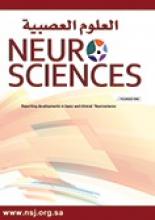Abstract
OBJECTIVE: Determination of the prevalence rate of emotional or behavioral problems, or both, among male Saudi schoolchildren and identifying the possible risk factors behind these problems.
METHODS: The study was conducted from March-May, 2003 and included all male schoolchildren of Al-Abnae schools specialized for the sons of the employees of the Saudi Ministry of Defense (military and civilians) in Taif Governorate, Kingdom of Saudi Arabia (total number 1416 students). It was conducted through 2 phases: A screening phase (using the Child Behavior Checklist “Parent’s form”) for all schoolchildren and adolescents included in the study through a cross-sectional approach to assess their emotional and behavioral problems, and a case-control phase to study risk factors.
RESULTS: Among the 1313 male schoolchildren that participated in the study, 109 (8.3%) were emotionally or behaviorally disturbed students. Among studied sociodemographic variables, only educational level (intermediate versus primary) and mother’s occupation (working versus non working) was associated with a higher risk of developing emotional or behavioral disturbance. Unwanted pregnancy (odds ratio [OR]=4.77, confidence interval [CI] 3.68-5.86), history of meningitis (OR=7.50, CI 5.12-9.88), history of accidents (OR=4.07, CI 2.87-5.26) and those with history of bronchial asthma (OR=2.96, CI 2.16-3.76) had an increased risk of emotional or behavioral disturbance.
CONCLUSION: The prevalence rate of behavioral and emotional disturbance according to parent’s reports is lower than that reported in other countries. Several risk factors including child, familial, and environmental risk factors play an important role in the genesis of emotional and behavioral problems in schoolchildren. Mental health problems can be recognized and treated; caring families and communities working together can help.
- Copyright: © Neurosciences
Neurosciences is an Open Access journal and articles published are distributed under the terms of the Creative Commons Attribution-NonCommercial License (CC BY-NC). Readers may copy, distribute, and display the work for non-commercial purposes with the proper citation of the original work.






